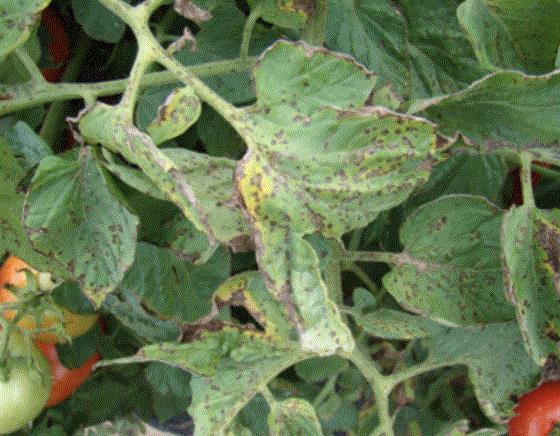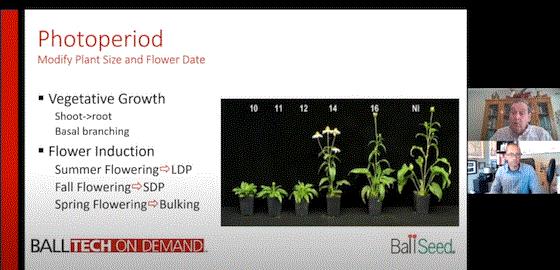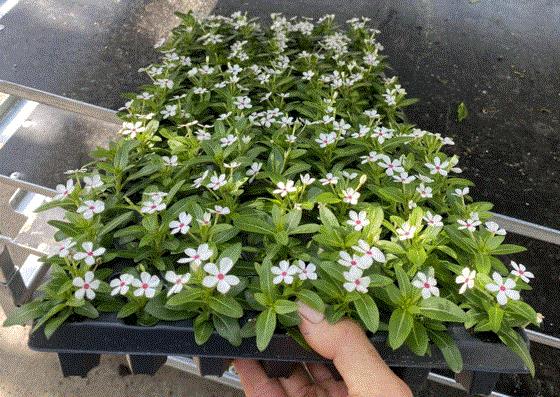Quick Video 1: Bacterial Leaf Spot on Tomato
If you’re growing tomato transplants for home gardeners, your team needs to be aware of one inherent risk to the crop: bacterial leaf spot (BLS). BLS is known to impact production if protocols aren’t followed to minimize the risk.

In this SHORT VIDEO, our Tech On Demand jack-of-all-trades Nick Flax (you may know him from such things as the tech tip you see every week in this newsletter) covers environmental, cultural and chemical controls for BLS. He shares the greenhouse temps that can encourage infection, the importance of buying seed from reputable sources, and minimizing stress to the plants. In terms of chemical applications, Nick runs through both biological and conventional products you can turn to for control.
Quick Video 2: Lighting to Hit Key Ship Dates
It’s always stressful when your customers have advertisements scheduled to promote the crops you supply, becaues it means you must hit targeted delivery dates—or else! Not only are you concerned about producing high quality, but your team needs to execute flawlessly to ship plants at just the right time.

Here’s a quick video from Dr. Will Healy, excerpted from a longer video on lighting, in which he focuses on using photoperiod to speed up or slow down flowering in ornamental crops. He discusses how photoperiod can be used to MODIFY PLANT SIZE AND IMPACT FLOWER INDUCTION in all seasons.
This is a great 3-minute video to share with your team!
Nick’s Tip of the Week: Physiological Disorder Bonanza
Each week, I’ll work with my buddy Nick Flax, a technical services expert at Ball, to share a concern that’s come up during one of his numerous calls with growers across North America. This week, he’s discussing two physiological disorders that might not be as serious as they look: intumescence and edema.
PROBLEM: It’s late March, your greenhouses are packed to the gills, and this is when the fun REALLY starts for tech folks like me! All week, my phone and email have been blowing up with questions like, “What the heck is this?”, “Any ideas here?” and “Is there such a thing as a plant STD? Because this sure looks like plant herpes …”
Multitudes of problems pop up when you have so many different crops tightly packed in the same greenhouse, but a recent trend in questions has put a spotlight on two common disorders that always seem to appear around this time each year.

NICK’S TIP: Let’s take a look at two timely physiological disorders, how to manage them, and why you shouldn’t worry too much if they show up in your crops.
Intumescence
While imtumescence have been linked to a lack of UVB radiation in greenhouse environments during crop production, it’s still not 100% clear why it occurs. However, this disorder results in some concerning symptoms, especially if you aren’t familiar with how to identify it, and growers are often freaked out—and understandably so—when they see it for the first time.
-
Early symptoms often present as rows of bumps or “pustules” along stems, leaf petioles and midribs. Depending on the crop, lesions may range in color from light to dark, and are sometimes translucent.
-
When symptoms are severe, lesions can coalesce into masses and often appear more broadly across the undersides and even on tops of leaves. As lesions mature, they often become darker in color and eventually take on a corky color and eventually become blackish-brown as the tissue senesces.
-
Intumescence is known to affect several crops, but sweet potato vine (Ipomoea batatas) and Black-eyed Susan vine (Thunbergia alata) are two of the most frequently reported. Tomato (Solanum lycopersicum) and Cuphea spp. are also more common victims of this disorder.
-
Lesions on Thunbergia, Cuphea and tomato are most often circular or spherical, while lesions on Ipomoea are often more angular or geometric in appearance when viewed under magnification.
-
At first glance, many growers mistake intumescence lesions as insect eggs, fungal spots or crown gall (Agrobacterium tumefaciens). However, if you see symptoms in your greenhouse on one or two of the crops mentioned in this week’s tip and not on anything else, it’s most likely just intumescence.
-
Some varieties are more prone to intumescence, so make note of any varieties that seem to be more affected than others in your operation. If customers express concerns or any of your crops are unsalable due to unsightly symptoms, it may be wise to avoid growing these varieties in the future.
While this is certainly an unsightly disorder, it won’t negatively impact overall development and health of the crop. Affected plant parts do not recover (lesions don’t disappear) but new growth tends to be less and less affected as spring progresses. If you receive young plants that have intumescence symptoms, don’t worry, they can be grown on to maturity without issue. Some selective cleanup and removal of affected leaves before plants hit retail may be advisable but be sure to wait until new growth is symptom-free before doing so.
Check out these awesome e-GRO Alerts on intumescence of Ipomoea and Thunbergia for some great photos and more details.
Edema … or oedema if you’re feeling fancy
This is another physiological disorder that often afflicts crops earlier in spring, but the reason it happens is much better understood, and thus it can be more easily managed. Edema occurs when turgor pressure (internal water pressure in plant cells) gets too high, which causes cells to rupture. The earlier you can catch edema symptoms and make necessary corrections, the better.
-
Water-soaked lesions on the undersides of leaves are one of the earliest symptoms. However, once the ruptured epidermal cells have closed and lesions are no longer wet-looking, they often resemble thrips damage.
-
As ruptured cells heal, they often take on a corky color. In severe cases, damaged cells develop into callused masses that resemble blisters. These blisters are almost always on the undersides of leaves and not visible from above, so growers often confuse this with rust, Agrobacterium or mite damage.
-
Geraniums, particularly ivy geraniums (Pelargonium peltatum), are one of the most edema-prone spring bedding plants. Much like intumescence, some varieties are more sensitive to edema than others.
-
Edema occurs most often when substrate moisture levels remain high for extended periods and weather is cloudy and/or relative humidity is high. Be sure to avoid overwatering and allow for thorough wet-to-dry cycles between irrigation events to reduce this tendency.
-
Increase air flow in the greenhouse to encourage transpiration, even if weather conditions make reducing relative humidity challenging. A little more air movement can make a big difference to reduce edema incidences and severity.
Mild edema seldom affects overall growth and quality of plants, and symptoms subside as weather improves, but severe damage can cause reduce aesthetic quality and cause leaf senescence. Geraniums with lots of senescent leaves can rapidly become Botrytis factories, so be sure to clean up heavily edema-damaged foliage ASAP and apply a broad-spectrum fungicide as a protectant, if necessary.

Tech Tip from Suntory: Soiree Catharanthus
I recently got a cool “case study” from Delilah Onofrey at Suntory. She wrote up some tips for success with Soiree catharanthus based on effective strategies employed by grower Dan Gravano in South Carolina. Delilah shared Dan's rooting and growing-on tips to help other growers nail this crop. She says northern growers in particular struggle with rooting Soiree varieties in the winter months.

Here are Dan’s secrets for success:
-
Keep soil temperature warm. Bottom heat when rooting these cuttings during winter and early spring is a must. Keep the root temperature in the mid-70s F. If you don’t have a good source of heat, you can cover trays with thin poly to build up soil temperature and create a microclimate, but then take the film off so the plants can breathe.
-
Start with a sprench. Sprenching media with Adept while rooting will help prevent fungus gnats. A Strobin-type fungicide, like Strobe 50WG, is beneficial.
-
Light ‘em up. Long days will speed up the crop, but it’s not necessary to wait for longer days to begin the crop. Supplemental lighting will help with faster and more uniform rooting. We use four hours of night interruption.
-
Keep soil moist, but not too wet. Provide adequate humidity and soil moisture, reducing as cuttings callous up. Allow roots to develop. If roots aren’t there, they can’t pump water. Fertilize at a lower ppm until roots are established. We use 50 ppm CalMag in prop.
-
Growing on. We root in a 105 hexagonal tray. Once fully rooted after 30 days, we transplant into 4.5 in. pots. After a month, we shear the plants back and space them out. No PGR is needed with these. We space them out and irrigate with a constant feed with 100+ppm CalMag. We do preventative thrips maintenance with a typical thrips-chemistry rotation.

Salvaging Smoke-Damaged Crops
Heaven forbid a fire should ever occurs in your greenhouse. If it does, human safety comes first, of course; and hopefully, no one is injured. But your crops are also important, and actions can be taken to keep them healthy and viable. If the fire is short-lived, and other damage like significant amounts of ash or even freezing (if the incident happens in winter) are avoided, here are some tips to help keep crops healthy after such a disaster.

Assuming the growing area was successfully vented, there's not much need for rinsing unless there's noticeable residue on the foliage. Leaching the growing media is most likely not necessary. If damage is going to occur, it will most likely be on above-ground plant parts from exposure to volatile compounds in the air during the burn, but the exposure has already passed, and harmful gasses have been flushed out.
With any luck, damage will be minimal, but you can expect to at least see some burn along the leaf margins show up in the days following a fire—especially on young, tender growth. Also, you may see leaf twisting or yellowing/leaf senescence on ethylene-sensitive crops, but maybe not. It’s hard to know exactly what was in the smoke.
For crops that DO have ash/residue on the foliage, it’s suggested you clean it off:
-
Start with a clear water rinse using a hydraulic sprayer (dial it back to about 150–200 psi) or a fan-pattern volume-reduction hose nozzle. The goal here is to rinse in a couple of passes using low to moderate pressure and relatively small droplets. This will get them cleaned off but prevent soaking of the growing media.
-
For stubborn residue or crops that have scabrous, fuzzy or sticky trichome-covered leaves, use of a wetting agent like Capsil may be helpful to loosen it up. If you need to do this, come back and do a final pass with clear water (without wetting agent) pretty quickly. If anything in the ash/residue is phytotoxic, clean it off ASAP. Do your best to not loosen and spread it out over the leaf surface, because that will make it easier for the plant to absorb.
-
If phytotoxicity occurs from exposure to materials during the burn, damaged tissue will provide an entry point for pathogens. A suggestion would be to apply a broad-spectrum fungicide on affected crops first thing the following morning. Also, while plants may not have frozen, pay special attention to chilling-sensitive crops that may have gotten cold while the greenhouse was temporarily uncovered.

Finish Line ...
As we head into the busiest time of year for most greenhouse businesses, I always think about the importance of employee morale and positivity. This is critical content for managers, as well as anyone else on a team because of how much it impacts day-to-day performance.

When morale is high and things are “clicking,”great benefits can be achieved. I was reading an article from the BetterUp blog earlier in the week and spotted a concise list of the positive byproducts of positive morale and figured I’d share them:
-
Employee retention. Low morale can make employees feel helpless, undervalued and ignored. This often results in higher turnover.
-
Work performance. High morale inspires employees, leading them to perform at their very best.
-
Employee motivation. When employees are given opportunities to develop their skills, it motivates them to take action to accomplish their work goals.
-
Communication. When employees have solid relationships with their managers and co-workers, they communicate effectively and have positive attitudes.
-
Employee productivity. When employees believe in their company’s mission and can see themselves advancing their careers, they produce more work at a faster rate.
-
Collaboration. Employees who are in sync with their peers are motivated and excited to collaborate with other team members on new projects.
-
Employee engagement. High morale encourages employees to feel more engaged with the work in front of them, instead of feeling overwhelmed.




Please feel free to send your comments, constructive criticism and topic ideas to me at bcalkins@ballhort.com.

Bill Calkins
Editor - Tech On Demand
This email was received by you and 26,325 other fine subscribers!
If you're interested in advertising in Tech On Demand, contact Kim Brown ASAP and she'll hook you up.